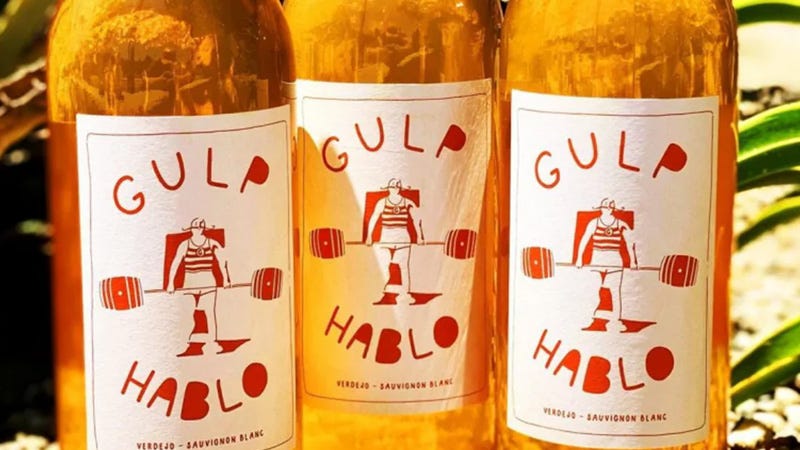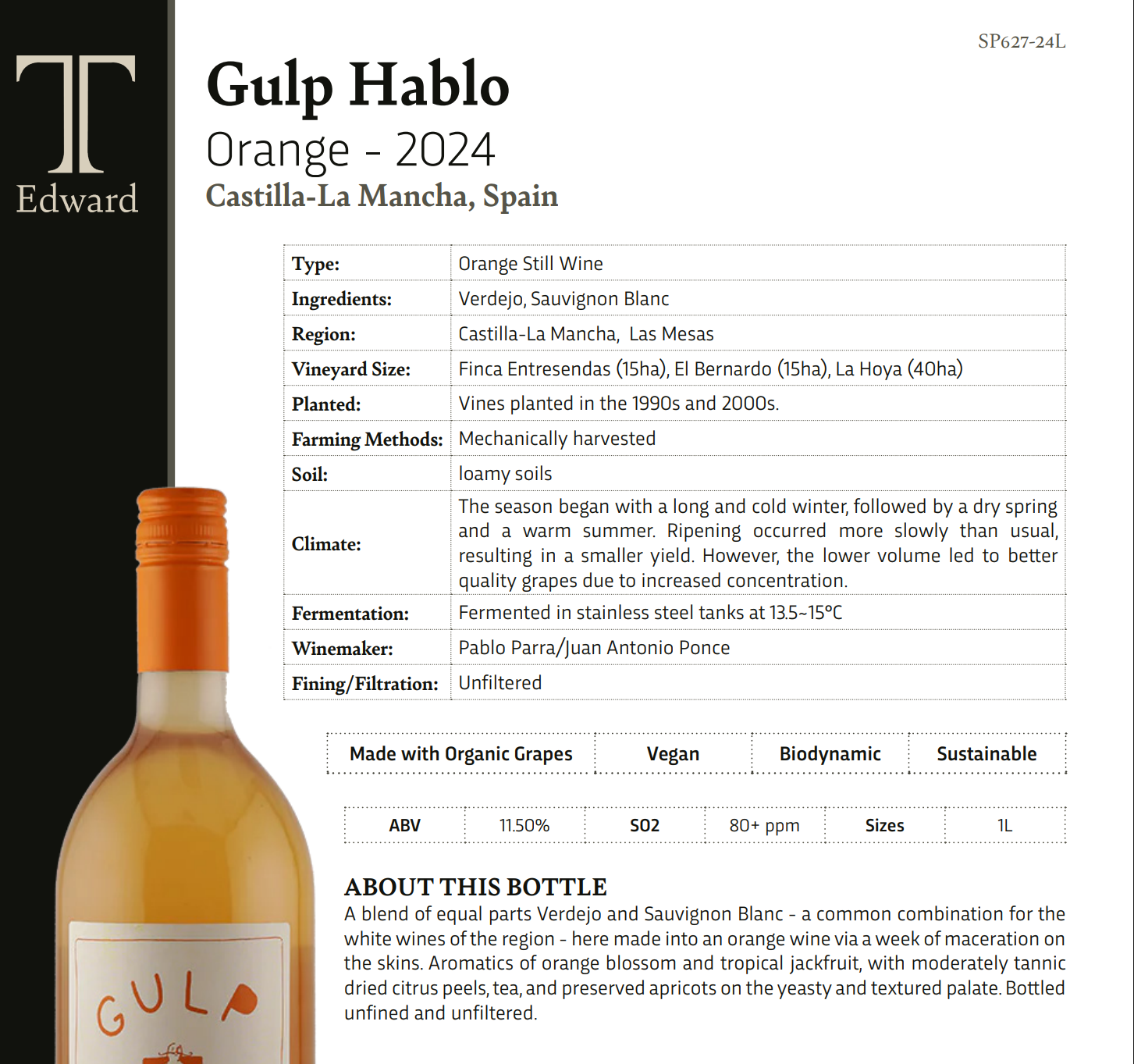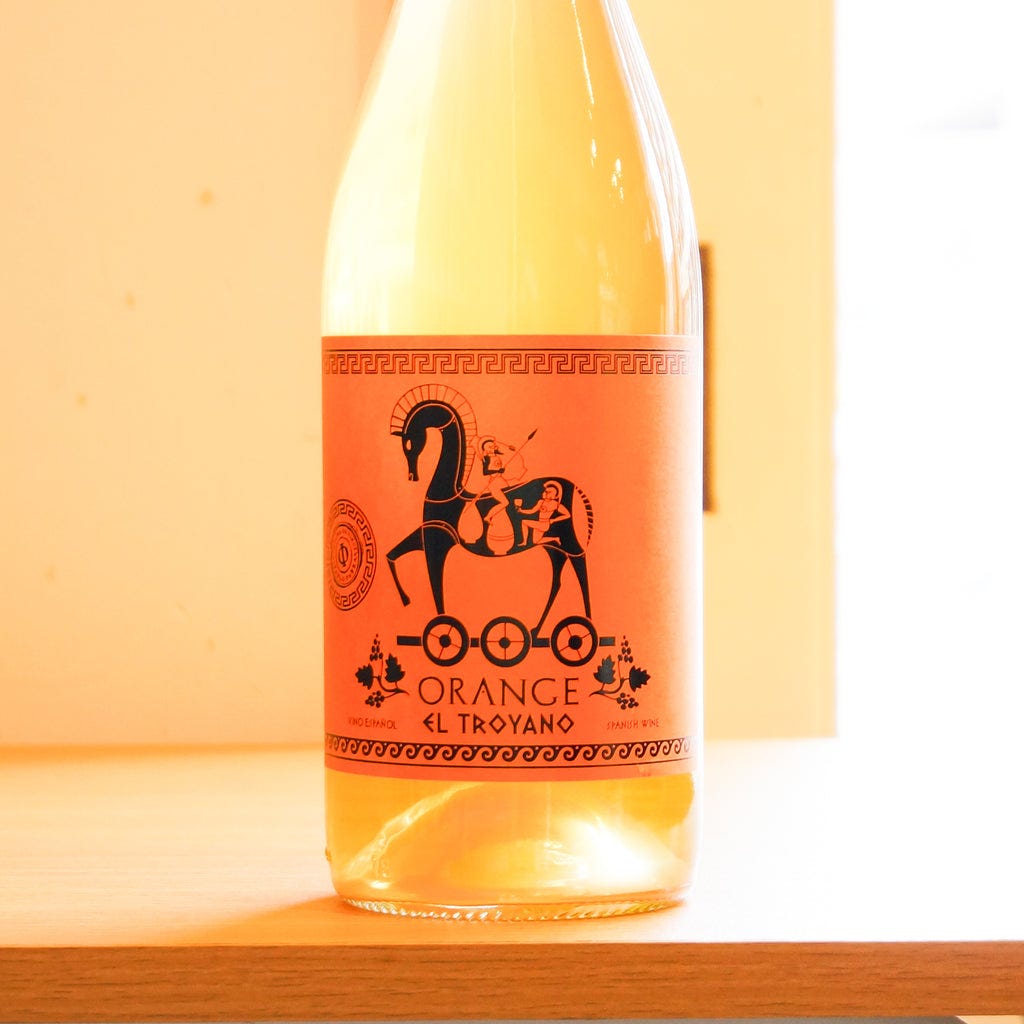Does Gulp Hablo Prove the Future's Orange?
The latest ruffling of feathers on planet natty, and what it means
Last week, a storm erupted in a natural wine glass - you know, one of those tiny teacup-sized things that hip wine bars still seem to think is cutting edge.
The subject was a Spanish biodynamically farmed Verdejo/Sauvignon Blanc blend made in massive quantities and sold at a bargain price. Or more accurately, a puff piece about said wine, published by US beverage site Vinepair: The Unstoppable Rise of Gulp Hablo, Everyone’s Favorite Liter of Orange Wine.
Natural wine commentators (notably, Alice Feiring) voiced robust criticism of the wine and its marketing. The article’s implication that Gulp Hablo is a natural wine was the sore point. Writer and fellow substacker Aiyana Thoma also weighed in on the matter:
It seems that much of the anger directed at Gulp Hablo was misplaced: neither the importer nor the producer make any claims that the wine is natural. The same can’t be said of retailers however, many of whom categorise it using the N-word.
Brand Gulp Hablo was created in 2017 as a collaboration between US importer T Edwards and Bodegas Parra Jiménez, a large biodynamic estate based in La Mancha. The first releases were an under-performing white and red, but the launch of Gulp Hablo Orange in 2021 turbocharged sales. The wine is a lightly skin-fermented blend of Verdejo and Sauvignon Blanc, retailing between $15 to $25 USD.
Everything from the label design to the wine’s stylistic profile is clearly inspired by the paradigm of natural. T Edwards touts the fact that it was produced from certified organic & biodynamic grapes, and that it is unfiltered and unfined. They provide a more than transparent tech sheet online, which reveals some red flags for hardcore natural fans. The main turn-offs are the stated 80 mg/L added sulphites, machine harvested grapes and cold fermentation with controlled temperature.
So no, Gulp Hablo wouldn’t fit most people’s definition of natural. It’s more of an homage to the idea, if you’re being kind. Or a calculated marketing ploy to appropriate the concept, if you’re feeling less benevolent. The brand adopts natural wine vernacular - one litre clear glass bottle, cartoonish label, low alcohol, no appellation or other geographical information on the front label - without adhering to the fine print.
In that sense, Feiring and Thoma’s irritation is justified: Gulp Hablo represents a kind of cultural appropriation. As Adam Teeter put it in an episode of the Vinepair podcast released a few days later, “they’re creating something that’s winking and nodding to a movement while not fully embracing that movement.”
Teeter’s comment was not intended to be negative. He and his colleagues gush about the success of the wine and the brilliance of its conception. The counter-argument - for those who believe in natural wine as a philosophical construct - is that it plays fast and loose with the ethic, deceiving customers into thinking the product is something it’s not.
What does it all mean?
The wine is currently only available in the US and the UK, and I’ve not tasted it. But I did dig a little deeper.
According to Vinepair, 300,000 bottles of the 2024 vintage were imported to the US. That might make it the most mass-produced orange wine ever. The closest competitors are probably Romanian giant Cramele Recaș (who produce around 75,000 bottles of their Orange Natural Wine) or the Iconic Italian winery La Stoppa, who make roughly the same quantity of Ageno each year. There are major Georgian wineries with orange/amber/qvevri ranges who produce larger quantities overall - but I don’t know of any other single orange line produced at this scale.
I wondered if the winery had to purchase grapes to support such major production - which might compromise the organic or biodynamic claims. But Bodegas Parra Jiménez owns 180 hectares (according to their website), and the techsheet namechecks the three massive vineyards (totalling 70ha) used for Gulp Hablo Orange’s production. So apparently no flies on the raw materials. Based on these figures, yields would be just under 35hl/ha - for comparison, this is the legal limit for yields from a Grand Cru Burgundy appellation.
Radical natural wine fans will take exception to the machine harvesting, on the grounds that it damages vines and compromises grape selection. But machine harvesting is vastly cheaper for the producer, making it feasible for Gulp Hablo to sell at such an accessible price-point. Is that necessarily bad?
As someone who believes passionately in synthetic-free farming, I’d much rather wine lovers bought a well-priced bottle produced from exemplary viticulture. Not only can wines like this function as a gateway, they also set an example: something honestly produced and well priced that comes with sound ethical and sustainable credentials. It needn’t be a toss-up between pricey natural wine or 19 Crimes.
Orange FTW!
The most interesting takeaway is arguably that Gulp Hablo succeeded when they released an orange wine. Not red, white or rosé. More traditionalist wine commentators still like to sneer at this category, and continue to suggest that orange wines are inaccessible and hard to like. These hacks have clearly never met any of the happy Gulp Hablo customers.
The US has a huge customer base that loves this style - something juicy and smashable with a bolder colour and flavour profile than cheap Pinot Grigio or neutral oaky Chard.
T Edwards’ officer for growth, Anthony Zraly, is quoted in the Vinepair article and it’s quite the statement:
“Never in my professional experience have I ever seen a wine in such demand and sell out so quickly. It was hard to wrap my mind around it.” Since its launch, Gulp Hablo’s orange expression has grown 150 percent year-over-year, with 25,000 cases imported to the U.S. for the 2024 vintage.
It seems clear enough that the landscape of wine and wine retailing is changing. There is a market for wines that suggest the idea of natural, whilst adhering to the ethical or sustainable piece. So long as those wines are well priced and produced in an easy-drinking style, they sell like hot cakes.
This is clearly irksome for the natural wine community, which casts its protagonists as the pioneers whose ideas are being stolen or imitated by the mass-market. But imitation is the sincerest form of flattery.
And anything that persuades wine lovers to try a different category, an unfamiliar grape or something less generic than Gallo, Jacob’s Creek or Yellow Tail is surely positive.
Gulp Hablo’s Orange might be one of the first such wines to be produced at this scale, but there are a number of forerunners and similarly well priced Spanish oranges. Here are some examples:
Bodegas Cueva's Orange is an easy-going, ‘orange-lite’ affair that sells in the EU for a similar or lower price than Gulp Hablo Orange. The grapes are hand harvested and the wine is genuinely low in sulphites.
€16.75 from Gourmet Hunters.
Citizen Kane’s Ginja Ninja delivers yet more skin fermented Verdejo from Spain. The producer is a UK-based negociant. Some vintages of this wine have been quite funky, others a little more foresquare.
€15.50 from Daxivin.
Parra Jimenez’s El Troyano Orange is 100% Verdejo from La Mancha - and yes, this is the same family that produces the grapes for Gulp Hablo. It’s pretty outspoken and a total fruit-bomb. I assume that machine harvesting may once again have been deployed.
€13 from A Taste Affair.
Although neither orange nor from Spain, it’s worth mentioning Claus Preisinger’s Puszta Libre, which has become the standard bearer for entry level natural wine. A super-lightweight, high-acid reddish wine (almost more of a rosé), it’s produced from biodynamically farmed fruit - although the winery does buy in grapes and is somewhat opaque about the quantity they produce. No machine harvesting or high sulphite additions though.
€12.90 from 8 Green Bottles.










Yes, exactly, let's not bicker over wine categories and winemaking semantics and let's celebrate this rare wine win -- we can ignite the debate again once the wine industry is growing strong again, for now take the "W".
What it comes down to looks to me like intentionally misleading the market (by not forcefully correcting resellers deliberate or ignorance based untrue marketing. Untrue marketing can not only mean what’s written or spoken about a product it’s also not correcting people’s perceptions based on what they’re led to believe). A wine with this much sulphur in it is a conventional wine, doesn’t matter if it’s “orange” or not.